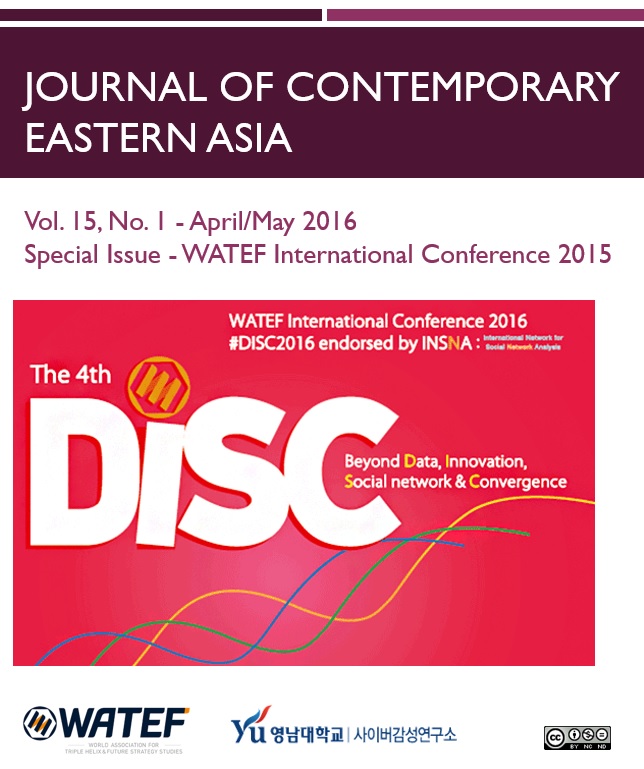- KOREAN
- E-ISSN2383-9449
- SCOPUS
 E-ISSN : 2383-9449
E-ISSN : 2383-9449
Multidisciplinary Team Research as an Innovation Engine in Knowledge-Based Transition Economies and Implication for Asian Countries -From the Perspective of the Science of Team Science
Abstract
This work identifies the key factors influencing the success of multidisciplinary, interdisciplinary, and trans-disciplinary R&D projects in transition economies by integrating knowledge management, organizational, inter/intra-collaboration (open-innovation), and leadership perspectives, while also addressing the perspective of the science of team science, which is an integrative approach to R&D. This is followed by providing the major sub-constructs of team science and policy implications to better facilitate multidisciplinary, interdisciplinary, and transdisciplinary R&D projects in knowledge-based transition economies.
- keywords
Reference
Argyris, C.. Good Communication That Blocks Learning.
Bettencourt, L. A., A. W. Ulwick. The Customer-Centered Innovation Map.
Cohn, J., J. Katzenbach, and G. Valk. Finding and Grooming Breakthrough Innovators.
Collins, J.. Level 5 leadership: The triumph of humility and fierce resolve.
Dzisah, J. & Henry Etzkowitz. Triple Helix Circulation: The Heart of Innovation and Development.
Ericsson, K. A., M. J. Prietula, E. T. Cokely. The Making of an Expert.
Eckert, R. A.. Where Leadership Starts.
Faems, D., B. Van Looy, K. Debackere. Interorganizational Collaboration and Innovation: Toward a Portfolio Approach.
Gabriel, I.. Giving meaning to work: the spiritual challenge of our time.
Garnier, J.-P.. Rebuilding the R&D Engine in Big Pharma.
Goffee, R & Gareth Jones. Why Should Anyone Be Led by You.
Goleman, D.. What Makes a Leader?.
Gray, B.. Enhancing Transdisciplinary Research Through Collaborative Leadership.
Hansen, M. T., J. Birkinshaw. The Innovation Value Chain.
Heifetz, R. A. & Marty Linsky. A Survival Guide for Leaders.
Huang, J. C., S. Newell. Knowledge integration processes and dynamics within the context of cross-functional projects.
Huckman, R. S.. Are You Having Trouble Keeping Your Operations Focused?.
Jones, B. F., S. Wuchty, B. Uzzi. Multi-University Research Teams: Shifting Impact, Geography, and Stratification in Science.
Jouret, G.. Inside Cisco's Search for the Next Big Idea.
Katila, R., G. Ahuja. Something Old, Something New: A Longitudinal Study of Search Behavior and New Product Introduction.
Kim, W.C., R. Mauborgne. How Strategy Shapes Structure.
Koput K. W.. A Chaotic Model of Innovative Search: Some Answers, Many Questions.
Kotter, J. P.. What Leaders Really Do.
Laursen, K., A. Salter. Open for Innovation: The Role of Openness in Explaining Innovation Performance among U.K. Manufacturing Firms.
Lee, K. & C. Lim. Technological regimes, catching-up and leapfrogging: Findings from the Korean industries.
Lee, Y.-G.. Strengthening Competency Linkage to Innovation at Korean Universities.
Lee, Y.-G., J.-H. Lee. Different characteristics between auctioned and non-auctioned patents.
Lee, Y.-G.. Sectoral strategic differences of technological development between electronics and chemistry: A historical view from analyses of Korean-invented US patents during the period of 1989 to 1992.
Lee, Y.-G., S. Park, Y. Song. Which is Better for a Firm's Financial Performance: An Externally Oriented or Inwardly Oriented Innovation Strategy? An Empirical Study of Korean SMEs.
Lee, Y.-G.. What Affects a Patent's Value? An Analysis of Variables That Affect Technological, Direct Economic, and Indirect Economic Value: An Exploratory Conceptual Approach.
Lee, Y.-G., J. Lee, Y. Song, H. Kim. Technological convergence and open innovation in the mobile telecommunications industry.
Masse, L. C., R. P. Moser, D. Stokols, B. K. Taylor, S. E. Marcus, G. D. Morgan, K. L. Hall, R. T. Groyle, W. M. Trochim. Measuring Collaboration and Transdisciplinary Integration in Team Science.
Mintzberg, H.. The Manager's Job- Folklore and Fact.
Mintzberg, H.. Productivity Is Killing American Enterprise.
Mizik, N., R. Jacobson. The Cost of Myopic Management.
Nambisan, S., M. Sawhney. A Buyer's Guide to the Innovation Bazaar.
Nidumolu, R., C. K. Prahalad, M. R. Rangawami. Why Sustainability Is Now The Key Driver of Innovation.
Park, S.-h., Y.-G. Lee. Perspectives on Technology Transfer Strategies of Korean Companies in Point of Resource and Capability Based View.
Peace, W. H.. The Hard Work of Being a Soft Manager.
Peters, T. J.. Leadership: Sad Facts and Silver Linings.
Porth, S. J., J. McCall. Contemporary Management Theories and Catholic Social Teaching: A Review and Analysis.
Sengupta, K., T. K. Abdel-Hamid, L. K. Van Wassenhove. The Experience Trap.
Song, Y., D. Lee, Y.-G. Lee, Y. Chung. Managing uncertainty and ambiguity in frontier R&D projects: A Korean case study.
Sorcher, M., Brant, J.. Are You Picking the Right Leaders?.
Stokols, D., S. Misra, R. P. Moser, K. L. Hall, B. K. Taylor. The Ecology of Team Science: Understanding Contextual Influences on Transdisciplinary Collaboration.
Takeuchi, H., E. Osono, and N. Shimizu. The Contradictions That Drive Toyota's Success.
Teasley, S., S. Wolinsky. Scientific Collaborations at a Distance.
Tripsas, M.. Unraveling the Process of Creative Destruction: Complementary Asset and Incumbent Survival in the Typesetter Industry.
Zahra, S. A., A. P. Nielsen. Sources of Capabilities, Integration and Technology Commercialization.
Zaleznik, A.. Managers and Leaders: Are They Different?.
- Downloaded
- Viewed
- 0KCI Citations
- 0WOS Citations
